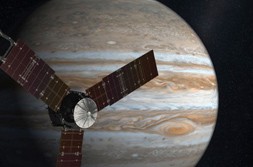Jupiter: Galileo to Juno

By Robert Marshall
The first recorded telescopic observations by Galileo over 400 years ago depicted a “wandering star,” today known as a planet, which disobeyed the laws of nature. With an oval-like outline it was clearly not perfectly spherical as all heavenly bodies were believed to be, and more importantly its newly discovered moons, or natural satellites, appeared, over the course of several nights, to orbit Jupiter itself, not the Earth.
These were among the first clues that the Solar System might be centered on the Sun, which amounted to a very outrageous viewpoint during the 17th century. But even today, in the 21st century, Jupiter still harbors secrets waiting to be revealed.
What Scientists Know
Just as Earth has clouds that can be seen from space, so does Jupiter — but that’s where the similarities end. Made entirely of hydrogen and helium gases, Jupiter is simply a gigantic ball of atmosphere consisting of clouds, belts and zones. These features form stripe-like bands where both the red and white colors alternate as well as their rotating directions. But these are swirling clouds of mystery.
Jupiter’s Great Red Spot, which by itself spans twice the size of Earth, is identified as a storm whose activity can be traced for hundreds of years through observation. Yet what drives it is still unknown.
Juno Jets to Jupiter
As the largest planet in the solar system, Jupiter has the greatest gravitational field (second to the Sun), making any spacecraft approach tedious. This past summer, on July 4, almost five years after its August 5, 2011 launch, Juno initiated a 35-minute engine burn at more than three million miles away to begin its orbit and insertion of the King Planet. On August 27, 2016, during Juno’s nearest approach of a mere 2,600 miles above the cloud tops, it passed by Jupiter closer than any other previous spacecraft.
During this and the next 30 orbits, before an eventual planned crash into the atmosphere, Juno will not only undergo extreme gravitational forces but will pass through debris fields that rival the rings of Saturn and radiation levels more than six million times stronger than those found naturally here on Earth.
If Juno can survive long enough it will map gravitational and magnetic fields as well as help determine if Jupiter has an interior core. Such data will play a pivotal role in helping us answer deeper questions about the formation and evolution of our Solar System.
CLASSROOM DISCUSSION
- How might an event like Comet Shoemaker-Levy 9’s crash into Jupiter in 1994 make us think about adding another constraint to the Drake Equation?
VOCABULARY
- Atmosphere
- Gravitational Field
- Radiation